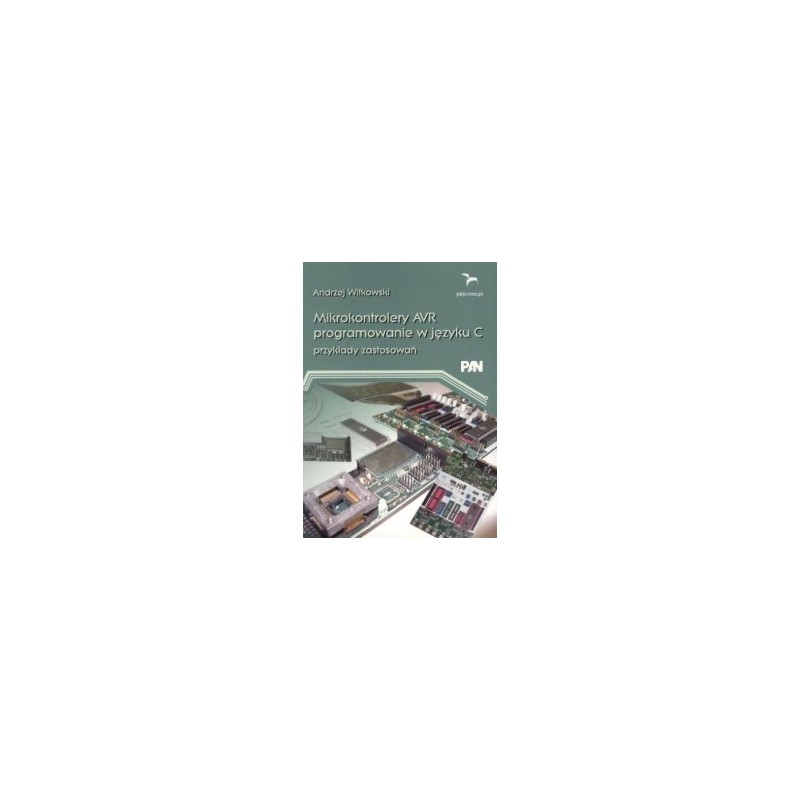- Out-of-Stock



Andrzej Witkowski

free shipping in Poland for all orders over 500 PLN

If your payment will be credited to our account by 11:00

Each consumer can return the purchased goods within 14 days
The book describes a programming environment that is a set of free tools built around avr-gcc - the GNU C compiler for AVR processors. It is intended for all those who create or want to create programs written in C language for AVR microcontrollers. In particular, it is addressed to students of electronic and electrical fields as well as hobbyists who build devices with AVR microcontrollers. It can also be used by readers professionally involved in the programming of microcontrollers and all those who, while programming them in Assembler so far, want to expand their skills.
Table of Contents
1. Introduction
1.1. Basic information
1.2. The structure of the book
1.3. Sources of information
2. The GNU C development environment
2.1. Introduction
2.2. Environmental component programs
2.2.1. The Gnu Binutiis package
2.2.2. The GCC package
2.2.3. Avr-libc library
2.2.4. Make program
2.2.5. Programmers
2.2.6. Development tools
2.2.7. assemblers
2.2.8. Auxiliary programs
2.3. Installation
2.3.1. Windows system
2.3.2. Linux system
2.4. Avr-libc library
2.4.1. Start code
2.4.2. Definitions of special register names and bit flags
2.4.3. Mathematical library
2.4.4. Standard library C
2.4.5. Macros and functions that facilitate the use of peripheral systems
2.5. Gcc compiler
2.5.1. Principle of operation
2.5.2. Types of files
2.5.3. Options
2.5.3.1. Compiler options specific to AVR processors
2.5.3.2. Options controlling the type of result
2.5.3.3. Options fixing the dialect C
2.5.3.4. Options that enable or disable comments and error information
2.5.3.5. Options for the debugger
2.5.3.6. Optimization options
2.5.3.7. Directory options
2.5.3.8. Options determining how to generate the code
2.5.3.9. Preprocessor options
2.5.3.10. Assembler options
2.5.3.11. The options of the consolidator
2.5.4. Attributes of variables and functions
2.6. Make program
2.6.1. Principle of operation
2.6.2. Dependencies
2.6.3. Variables
2.7. The AVRDUDE program
2.7.1. Command line options
2.7.2. avrdude-gui
3. C language for AVR processors
3.1. Introduction
3.2. Operations on variables and special registers
3.3. Operations on bit variables
3.4. Volatile variables
3.5. References to different types of memory
3.5.1. Address spaces
3.5.2. EEPROM memory
3.5.3. Flash memory
3.6. Interrupt service
3.6.1. Declarations of the interrupt function
3.6.2. Hierarchy of interrupts
3.6.3. Preferably from the same variables in breaks and in the main program
3.6.4. Use in interrupt from global variables
3.7. Modifications to the start code
3.8. assembler
3.8.1. Rules for allocating registers by the compiler
3.8.2. Assembler as
3.8.2.1. Comments
3.8.2.2. expressions
3.8.2.3. labels
3.8.2.4. Directive
3.8.2.5. Cpp preprocessor
3.8.2.6. Example code in Assembler attached to C
3.8.3. Inserts in Assembler
3.8.3.1. Instruction asm
3.8.3.2. operands
3.8.3.3. Application examples
4. Creating the program
4.1. Basic principles
4.2. Creation and compilation of the project
4.2.1. AVR Studio
4.2.2. Mfile makefile file generator
4.2.3. Template for makefile files from WinAVR
4.3. Sample program
4.4. Compilation of the example program
4.4.1. AVR Studio
4.4.2. Command line
4.5. Project files
5. Examples of applications
5.1. Introduction
5.2. Operation of the matrix keyboard
5.2.1. Application description
5.2.2. implementation of
5.3. Data exchange via a serial interface
5.3.1. Application description
5.3.2. implementation of
5.4. Alphanumeric LCD display
5.4.1. Application description
5.4.2. implementation of
5.5. Keyboard support in interrupts
5.5.1. Application description
5.5.2. implementation of
5.6. Keyboard and LED display support
5.6.1. Application description
5.6.2. implementation of
5.7. Communication between multiple devices
5.7.1. RS-485 interface
5.7.2. Protocol description
5.7.2.1. Data frame formats
5.7.2.2. Error handling
5.7.3. Communication session
5.7.4. implementation of
5.7.4.1. Constants and variables used in the program
5.7.4.2. The parent system
5.7.4.3. Subordinate system
5.7.5. Time dependencies
5.7.5.1. Measure the gap between characters inside the frame
5.7.5.2. Measuring the gap between frames with requesting responses and data,
5.7.5.3. Measuring the gap between frames by the slave system
5.7.6. Data exchange
Attachment
Literature
Alphabetical index
No product available!
No product available!
PCB for amplifier for pulse generator. AVT1961 A
No product available!
No product available!
No product available!
Imagine the future of space exploration with Ugears\' Manned Mars Rover, an all-terrain planetary explorer with 6x6 all-wheel drive, a cab for two astronauts, spring-driven motor, a swivel between cab and body, and fully-sprung independent suspension. This DIY model space rover has its front centerline pushed forward for better climbing and stability, front wheels that turn for maneuverability, and large diameter wheels to overcome obstacles while navigating the Martian landscape. A ramp folds down in the back, while a top-mounted dish antenna rotates 360° and can swivel up and down to transmit or receive signals to and from the base. UGears 70206
No product available!
No product available!
No product available!
No product available!
No product available!
Extensive signal analysis kit including the Analog Discovery 2 adapter, Analog Discovery BNC adapter, breadboards, BNC probes, cables with Minigrabber connectors and crocodile clips and necessary accessories. Digilent Ultimate Analog Discovery 2 Bundle (471-027)
No product available!
No product available!
No product available!
No product available!
No product available!
No product available!

Andrzej Witkowski
